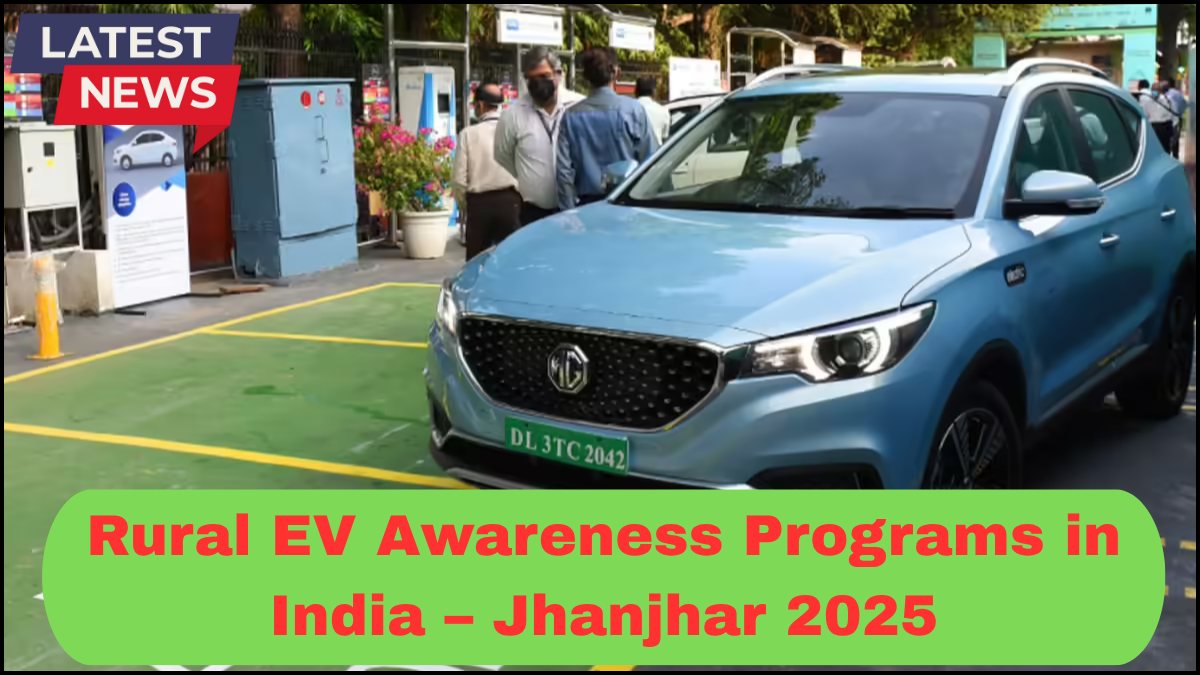India’s push toward sustainable transportation has moved beyond city borders. In 2025, the spotlight is firmly on rural India, where the Rural EV Awareness Program 2025 is gaining ground. One such initiative making waves is the Jhanjhar campaign—a mission to educate, empower, and enable the adoption of electric vehicles (EVs) in India’s heartlands.
This national program isn’t just about introducing electric vehicles to rural roads—it’s about integrating them into the daily lives of villagers, while ensuring infrastructure, support, and economic incentives follow suit.

Why Rural India Matters in the EV Ecosystem
India’s villages make up more than 65% of the country’s population. They are vital to any large-scale change, especially in sectors like agriculture, logistics, and local transport. Traditional fuel-based vehicles remain common in rural areas, but rising fuel costs and environmental concerns are prompting a shift.
This is where the Rural EV Awareness Program 2025 steps in. It recognizes the unique challenges faced by rural communities—limited access to information, inadequate charging infrastructure, and lack of trust in new technology—and seeks to address them directly.
Jhanjhar 2025: Driving Change at the Grassroots Level
Jhanjhar, a district selected as one of the flagship zones under this program, showcases a comprehensive model for rural EV integration.
Key Components of the Jhanjhar Campaign:
1. Community-Based Learning Sessions
Interactive sessions in schools, panchayats, and local community halls are organized to demystify EV technology. These workshops focus on:
-
How EVs function
-
Maintenance and lifespan
-
Cost savings over time
-
Environmental benefits
Local dialects and visual aids make these sessions more accessible and relatable.
2. Village Electrification Synergy
An important backbone to EV adoption is power availability. Jhanjhar’s campaign is closely tied to village electrification efforts. The state has fast-tracked the installation of solar microgrids and stable power supply lines to ensure EV charging is viable even in remote areas.
3. EV Demonstration Drives
Residents witness live demos of two-wheelers, three-wheelers, and small four-wheeler EVs suited for village use. Farmers are especially shown how electric tractors and carts can reduce operational costs without compromising productivity.
4. Training for Local Mechanics and Entrepreneurs
Skill-building is a key element. Mechanics are trained to service EVs, ensuring that support is available within the village itself. Additionally, local youth are encouraged to set up EV charging stations as a livelihood opportunity.
Partnerships Fueling Progress
The success of the Rural EV Awareness Program 2025 relies on collaboration. In Jhanjhar, NGOs, state governments, and EV manufacturers are working together to provide subsidies, build infrastructure, and drive adoption.
Subsidies are structured to make EVs affordable for low-income households. Partner banks offer low-interest loans tailored for rural buyers. Manufacturers like Tata, Mahindra Electric, and several e-rickshaw makers have committed to supplying vehicles that meet rural needs in terms of durability and cost.
Overcoming Challenges
Despite the momentum, hurdles remain:
-
Skepticism due to lack of exposure
-
Fear of maintenance costs
-
Limited awareness of government incentives
To combat this, the program leverages local influencers—teachers, village heads, self-help groups—to build trust. Posters, videos, mobile apps in regional languages, and even puppet shows are being used to reinforce the message.
Looking Ahead
Jhanjhar 2025 is more than just an awareness campaign—it’s a model of how India’s rural economy can align with global sustainability goals. If scaled effectively, it can catalyze a nationwide transformation, reduce carbon footprints, and enhance economic resilience in villages.
As EV adoption spreads, programs like this will be critical in ensuring the benefits of clean technology reach every corner of the country.
FAQs
Q1: What is the goal of the Rural EV Awareness Program 2025?
The program aims to educate rural populations about electric vehicles, promote adoption, and develop necessary infrastructure to support EV use in villages.
Q2: Why was Jhanjhar chosen for this initiative?
Jhanjhar was selected for its diverse rural population, potential for rapid electrification, and existing government development schemes that align with EV integration.
Q3: How does village electrification relate to EV adoption?
EVs require consistent power supply for charging. Village electrification ensures that households and charging points have the energy access needed to support widespread EV usage.
Q4: Are there financial supports for villagers to buy EVs?
Yes. Government subsidies, low-interest loans, and manufacturer discounts are part of the program to make EVs more affordable in rural areas.
Q5: What types of EVs are suitable for rural areas?
Electric two-wheelers, three-wheelers (e-rickshaws), small commercial EVs, and electric tractors are tailored for the needs and terrain of rural India.
click here to learn more